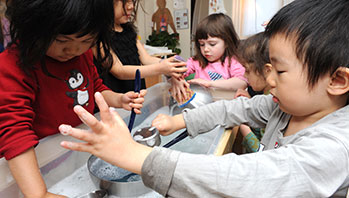- balance scale
- chart paper
- fruit and vegetables (use samples from yesterday’s exploration and add more if needed)
- magnifying lenses
- marker
- seeds (from yesterday’s exploration)
- fruit
- pit
- seed
- vegetable
MA Standards:
Language/L.PK.MA.6: Use words and phrases acquired through conversations, listening to books read aloud, activities, and play.
Language/L.PK.MA.5.a: Demonstrate understanding of concepts by sorting common objects into categories (e.g., sort objects by color, shape, or texture).
MA Draft STE Standards:
Life Sciences/From Molecules to Organisms: Inheritance and Variation of Traits/LS1/3.A: Describe/draw and compare the body parts of animals (including themselves) and plants they are investigating [System] and explain functions of some of the observable body parts. [Structure and Function]
Life Sciences/From Molecules to Organisms: Inheritance and Variation of Traits/LS1/3.C: Use their sense in their exploration and play to gather information. [Structure and Function]
Head Start Outcomes:
Logic and Reasoning/Reasoning and Problem Solving: Classifies, compares, and contrasts objects, events, and experiences.
Science Knowledge/Scientific Skills and Method: Observes and discusses common properties, differences, and comparisons among objects.
Language Development/Expressive Language: Uses increasingly complex and varied vocabulary.
PreK Learning Guidelines:
English Language Arts/Language 2: Participate actively in discussions, listen to the ideas of others, and ask and answer relevant questions.
Science and Technology/Life Sciences 10: Observe and identify the characteristics and needs of living things: humans, animals, and plants.
Mathematics/Patterns and Relations 8: Sort, categorize, or classify objects by more than one attribute.
Explore Together (indoors): Sort Seeds and More Seeds

© Commonwealth of Massachusetts, Department of Early Education and Care (Jennifer Waddell photographer). All rights reserved.
STEM Key Concepts: Many foods that animals, including humans, eat come from plants; We eat certain leaves, roots, fruits, and seeds; Fruits have seeds; Seeds hold what a plant needs to make more of itself; People and other animals interact with their environment through their senses
ELA Focus Skills: Compare and Contrast, Listening and Speaking, Follow Directions, Predicting, Vocabulary
Educator Prep: You may need to add to the seed collection if children did not gather enough seeds from the samples yesterday for the sorting activity today.
- Prepare plates of small pieces of each food for children to sample as they explore.
- Save some fruit and vegetable slices for the Small Group activity.
Safety Tips:
- Remind children to wash their hands before and after the activity.
- Take children’s dietary needs into account before introducing them to any food items.
Focus children’s attention on the fruits and vegetables and then on the seeds. Have children name the fruit or vegetable each plate of seeds came from. Ask them to use sensory descriptive words to describe one of the fruits/vegetables. (tangy, sour, yummy, hard, smelly, squishy) Encourage children to use the new words they have learned (aroma, pit, seed) in their descriptions.
After children have identified the seeds, give each pair of children a mixed assortment of seeds and have them sort the seeds in different ways. (color, shape, texture, size, weight) Encourage children to draw, write, or dictate their findings so they can share them with the group. As children explore, circulate and engage them when you notice something of interest to them. Ask questions such as,
- What was different about the texture of the peach seed, or pit, compared to the avocado pit?
- What do you think will happen if you put the same amount of apple seeds and cherry seeds on the scale?
Reflect and Share
Discuss children’s observations. Encourage them to show their recordings as they discuss what they observed about seeds. Have extra materials available so children can point to them as they share what they observed. Prompt with questions such as,
- What was different about the apple seeds compared to the lemon seeds?
- Why do you think people and animals can eat cucumber seeds but not cherry seeds or pits?
- What did you notice when you compared the weight of the olive pit and the weight of the melon seeds?
- Do you think a squirrel could eat an avocado pit? Why do you think that?
